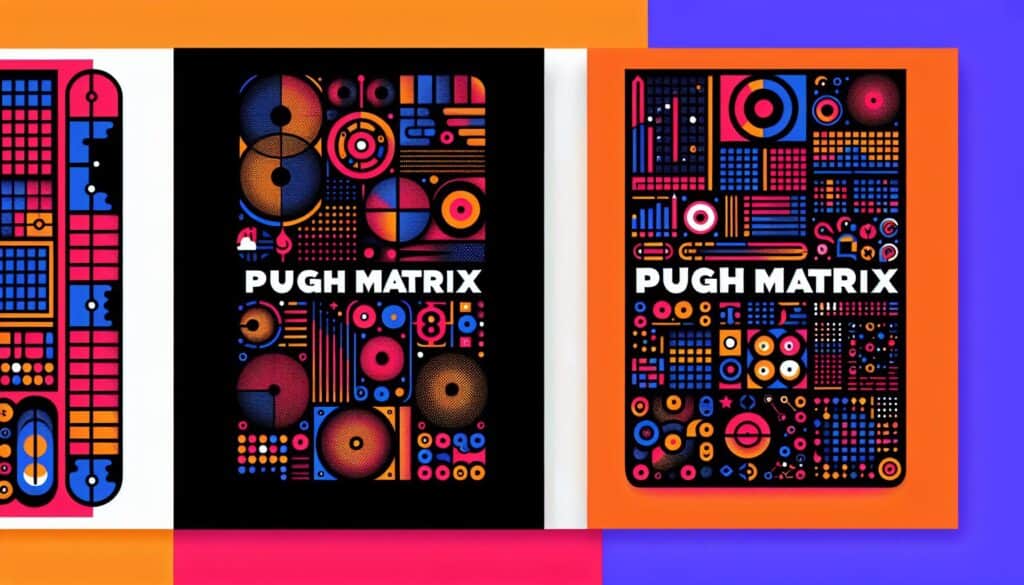Evaluar y comparar sistemáticamente varios conceptos o soluciones con un concepto de referencia y un conjunto de criterios.
- Metodologías: Clientes y marketing, Ideación, Diseño de producto
Matriz Pugh

Matriz Pugh
- Metodología ágil, Evaluación del diseño, Diseño para la sostenibilidad, Toma de decisiones con criterios múltiples (MCDM), Mejora de procesos, Desarrollo de productos, Gestión de proyectos, Despliegue de la función de calidad (QFD), Gestión de riesgos
Objetivo:
Cómo se utiliza:
- Se crea una matriz con los conceptos en forma de filas y los criterios de evaluación en forma de columnas. Cada concepto se compara con un concepto de referencia (dato) para cada criterio, puntuándolo como mejor (+), peor (-) o igual (S). A continuación, se suman las puntuaciones.
Ventajas
- Proporciona una forma estructurada y objetiva de comparar alternativas; ayuda a identificar los puntos fuertes y débiles de cada concepto; facilita el consenso del grupo.
Contras
- La selección de criterios y el concepto de referencia pueden influir significativamente en los resultados; la puntuación puede ser subjetiva si los criterios no están bien definidos; no pondera los criterios de forma inherente.
Categorías:
- Ingeniería, Resolución de problemas, Diseño de producto
Ideal para:
- Seleccionar el concepto más prometedor de un conjunto de alternativas basándose en múltiples criterios.
Pugh Matrix methodology proves beneficial in various stages of product design and development across multiple sectors, such as consumer electronics, automotive, and aerospace engineering, where innovation is a priority. This approach is particularly effective during the concept selection phase, where teams must evaluate diverse design alternatives against established performance metrics such as cost, usability, manufacturability, and sustainability. Cross-functional teams, comprising members from engineering, marketing, and user experience design, can collectively participate in this evaluation, ensuring that diverse perspectives are considered, leading to more robust decision-making. Competitors like the Quality Function Deployment (QFD) can complement this methodology by integrating customer requirements into the design process. By establishing a datum concept, teams can assess new ideas against a familiar benchmark, offering clarity and focus in the decision-making process. The scoring can illuminate aspects where certain concepts excel or fall short, offering clear visibility into potential risks and opportunities. This methodology encourages a thorough discussion among stakeholders and helps build consensus, which is particularly important in environments where iterative feedback and rapid prototyping are prevalent. Examples from industries highlight its utility; for instance, a team in the automotive industry may use the Pugh Matrix when evaluating new vehicle features, while a tech company may apply it to prioritize software functionalities, effectively guiding their development hoja de ruta. Successful implementation of this methodology can result in efficient allocation of resources, reducing time and costs associated with pursuing less viable ideas and ultimately accelerating the innovation cycle.
Pasos clave de esta metodología
- Create a Pugh Matrix with concepts as rows and criteria as columns.
- Select a baseline or datum concept for comparison.
- Score each concept against the datum for each criterion using +, -, or S.
- Aggregate scores for each concept across all criteria.
- Analyze scores to compare strengths and weaknesses of each concept.
- Identify the most promising concept based on aggregated scores.
Consejos profesionales
- Involve a diverse group of stakeholders during evaluation to capture varying perspectives that may highlight important but overlooked criteria.
- Regularly revisit and update the baseline concept to ensure it reflects current market conditions and technological advancements.
- Assign weights to evaluation criteria based on strategic priorities to enhance decision relevance and align with organizational goals.
Leer y comparar varias metodologías, recomendamos el
> Amplio repositorio de metodologías <
junto con otras más de 400 metodologías.
Sus comentarios sobre esta metodología o información adicional son bienvenidos en la dirección sección de comentarios ↓ , así como cualquier idea o enlace relacionado con la ingeniería.
Contexto histórico
1949
1950
1950
1960
1960
1960
1960
1940
1950
1950
1958
1960
1960
1960
1960
(si se desconoce la fecha o no es relevante, por ejemplo "mecánica de fluidos", se ofrece una estimación redondeada de su notable aparición)















Publicaciones relacionadas
Cuestionarios sobre molestias musculoesqueléticas
Pruebas multivariantes (MVT)
Análisis de regresión múltiple
Sistemas de captura de movimiento
Método MoSCoW
Prueba de la mediana de Mood